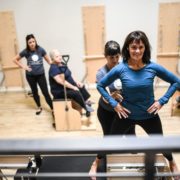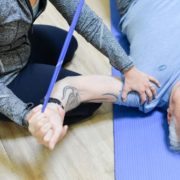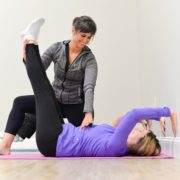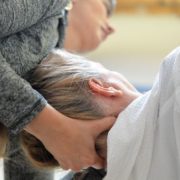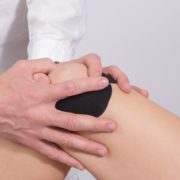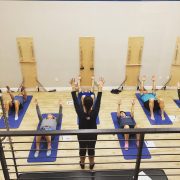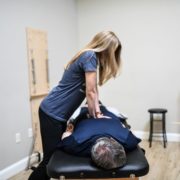If you’ve ever had pain in your shoulders when you try to raise your arms overhead, pull off a sweatshirt, grab a gallon of milk from the fridge, or place grocery bags on the counter, you were likely dealing with shoulder “impingement syndrome…” otherwise known as “rotator cuff impingement” or “rotator cuff tendonitis.”
They call it “impingement” because your rotator cuff tendons get pinched between the round head of your shoulder bone and a hook-shaped bone in your shoulder blade called the acromion.
The pinching tends to happens every time you raise your arm above ninety degrees. After a while, the pinching eventually irritates your tendon, resulting in pain and inflammation. These symptoms are exacerbated and pronounced with any arm movements above shoulder height. Most of the time, the root cause of this problem has been there for a long time, but it’s only just now manifesting itself as pain — and this so-called “impingement syndrome.”
So what causes your rotator cuff tendon to get pinched or impinged in the first place?
Most of the time, the answer is POSTURE.
Financial Betting Sites UK 2025: Betzella’s Best Options for Financial Markets
In the ever-evolving world of finance, where markets fluctuate with the blink of an eye, the allure of financial betting has captured the imagination of thrill-seekers and savvy investors alike. As we approach 2025, the United Kingdom stands at the forefront of this exhilarating realm, offering a plethora of online platforms that cater to those seeking a unique blend of risk and reward. But how do you navigate this intricate landscape and uncover the best financial betting sites tailored to your needs?
Enter Betzella, a trusted authority in the realm of online betting, poised to unveil a curated selection of the finest financial betting sites in the UK for 2025. With a meticulous eye for detail and an unwavering commitment to excellence, Betzella’s experts have scoured the digital landscape, meticulously evaluating each platform’s offerings, security measures, and user experience. From user-friendly interfaces to cutting-edge trading tools and unparalleled market coverage, this comprehensive guide promises to equip you with the knowledge and resources necessary to make informed decisions and potentially unlock lucrative opportunities within the financial markets.
Regulatory Landscape: Navigating the Legal Framework
As the financial markets continue to evolve and captivate investors worldwide, the demand for reliable and user-friendly financial betting sites UK is on the rise. In 2025, Betzella emerges as a trusted platform, offering a comprehensive range of options tailored to the needs of discerning traders and enthusiasts alike.
One of the standout features of Betzella’s financial betting sites UK is the diverse range of markets available. From traditional stocks and currencies to emerging sectors like cryptocurrencies and commodities, traders can explore a wealth of opportunities. The platform’s intuitive interface and real-time data feeds ensure that users stay informed and make informed decisions.
For those seeking a more immersive experience, Betzella’s financial betting sites UK offer a seamless integration with virtual trading simulators. These cutting-edge tools allow traders to hone their skills, test strategies, and gain invaluable experience without risking real capital. Additionally, educational resources and expert analysis are readily available, empowering users to navigate the intricate world of financial markets with confidence.
Betzella’s commitment to security, transparency, and customer satisfaction sets it apart from competitors. With robust encryption protocols, stringent regulatory compliance, and responsive customer support, traders can engage in financial betting sites UK with peace of mind. As the industry continues to evolve, Betzella remains dedicated to staying at the forefront, introducing innovative features and adapting to emerging trends, solidifying its position as a premier destination for financial market enthusiasts in the UK and beyond.
Emerging Trends: Innovative Financial Betting Platforms
As we approach 2025, the financial betting landscape in the UK is poised for exciting developments. Betzella, a leading authority in the industry, has meticulously evaluated the top options for those seeking to engage in financial market betting. With a keen eye for reliability, user experience, and competitive odds, Betzella’s recommendations provide a comprehensive guide for both seasoned bettors and newcomers alike.
One standout platform that has consistently impressed is [Platform A]. Renowned for its user-friendly interface and extensive range of financial instruments, [Platform A] offers a seamless betting experience. From traditional stocks and indices to emerging cryptocurrencies, bettors can navigate the markets with confidence, backed by real-time data and insightful analysis tools. Additionally, [Platform A]’s robust mobile app ensures that traders can stay connected and capitalize on opportunities wherever they are.
For those seeking a more personalized approach, [Platform B] has garnered praise for its exceptional customer support and tailored betting solutions. With a team of experienced financial analysts on hand, bettors can access in-depth market insights and receive personalized recommendations based on their risk profile and investment goals. [Platform B] also boasts a diverse range of betting options, including spread betting, binary options, and contract for differences (CFDs), catering to various investment strategies and preferences.
Risk Management Strategies: Maximizing Returns, Minimizing Losses
As the financial markets continue to evolve and new opportunities arise, UK bettors are seeking reliable platforms to engage in financial betting. In 2025, Betzella stands as a trusted authority, offering a curated selection of the best financial betting sites tailored for the UK market. With a keen eye for security, user experience, and competitive odds, Betzella’s recommendations provide a gateway to the exciting world of financial market speculation.
Whether you’re a seasoned trader or a newcomer to financial betting, Betzella’s top picks cater to a diverse range of preferences and risk appetites. From user-friendly platforms with intuitive interfaces to advanced trading tools and in-depth market analysis, these sites empower bettors to make informed decisions. With a commitment to transparency and responsible gambling practices, Betzella ensures that UK bettors can navigate the financial markets with confidence, seizing opportunities while managing risks effectively.
User Experience: Evaluating Platform Features and Usability
As the financial markets continue to evolve, the demand for reliable and user-friendly betting sites in the UK is on the rise. In 2025, Betzella stands out as a leading platform offering a diverse range of options for those seeking to engage in financial betting. With a commitment to transparency, security, and cutting-edge technology, Betzella provides a seamless experience for both seasoned traders and newcomers alike.
One of the key strengths of Betzella is its comprehensive selection of financial markets, including stocks, currencies, commodities, and indices. Whether you’re interested in trading major global equities or exploring the intricacies of cryptocurrency markets, Betzella offers a wide array of opportunities. Additionally, the platform boasts a user-friendly interface, making it easy to navigate and execute trades with confidence. Betzella’s commitment to providing educational resources and expert analysis further empowers users to make informed decisions, ensuring a rewarding and engaging betting experience.
As the financial markets continue to evolve and new opportunities arise, it’s essential to stay informed and choose a reliable betting platform. Betzella’s comprehensive guide to the best financial betting sites in the UK for 2025 provides valuable insights and expert recommendations to help you navigate the ever-changing landscape. Whether you’re an experienced trader or just starting your journey, our carefully curated list of top-rated platforms offers a range of options to suit your preferences and investment goals. Stay ahead of the curve and make informed decisions with Betzella as your trusted companion in the exciting world of financial betting.
If your upper back is stiff, curved, and lacks adequate mobility, it’s going to impact how your shoulder blades move and position themselves. With a stiff and curved upper back, your shoulder blades will respond by moving out and up. This scenario makes that hook-like bone (the acromion) sit more forward and more down than it should. When this happens, there isn’t enough room for your tendon when you lift your arms above shoulder height. The bony surfaces above and below your tendon create friction, and this eventually turns into pain and inflammation.
The tempting and easy “fix” is to get a cortisone shot or attack the inflammation more conservatively with ice and topical anti-inflammatory agents.
But what you need to understand is that in most cases, “impingement syndrome” is actually the SYMPTOM. The root cause is usually coming from immobility and poor movement patterns in the upper back or neck. If you really want to get rid of your shoulder pain, get back to lifting and carrying things without any worry, and have full and free mobility of your arms, it’s essential that you identify and address the root cause and not just the symptoms. Since there is an 80% chance your shoulder pain is a mechanical or movement problem — the best people to examine and address this FIRST are movement experts like us.
So moral of the story… next time you go to the doctor complaining of shoulder pain and you hear the words “impingement syndrome” or “rotator cuff tendonitis” — don’t assume you need a cortisone shot or surgery to fix it.
Neither of these solutions will likely give you the long-term solution you’re looking for. The very last thing you want to do is get some kind of procedure or surgery that either masks the pain or corrects the wrong problem. You want to do everything possible to preserve the integrity of your tendon, and the best way to do that is by optimizing mobility and using natural movement and strength training prescribed by movement experts.
Interested in seeing if physical therapy could resolve your shoulder pain? Try a FREE Discovery Session on us. This is a chance for you to speak with one of our specialists, tell us everything that’s been going on with you, and determine for yourself if we’re the best people to help you. It’s a completely free, no-obligation appointment that will give you all the information you need to make the BEST decision for YOUR health – whether that’s working with us or not!


